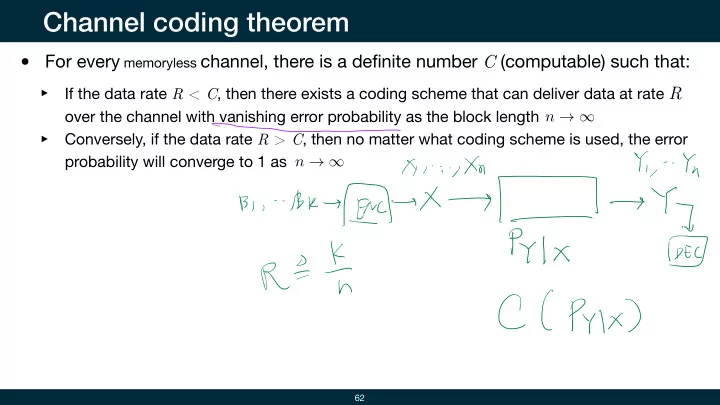

Channel coding theorem • For every memoryless channel, there is a definite number C (computable) such that: ‣ If the data rate R < C , then there exists a coding scheme that can deliver data at rate R over the channel with vanishing error probability as the block length n → ∞ ‣ Conversely, if the data rate R > C , then no matter what coding scheme is used, the error probability will converge to 1 as n → ∞ 62
������ AWGN channel model (discrete-time, real-valued) Z m ∼ N (0 , σ 2 ) V m = u m + Z m , m = 1 , . . . , n, Z m u m C comprises 2 nR length- n codewords u ∈ R n Codebook: 63
Sphere packing interpretation • By LLN, as , the received V will lie V = u + Z n → ∞ at the surface of the n -dimensional sphere R n centered at u with radius with √ n σ 2 probability 1 64
Necessary condition: capacity upper bound • maximum # of non-overlapping spheres = V = u + Z maximum # of codewords that can be R n reliably delivered • A necessary condition is p n ( P + σ 2 ) √ n n ( P + σ 2 ) 2 nR ≤ √ n σ 2 n � √ � n n ( P + σ 2 ) ⇒ R ≤ 1 1 � 1 + P � n log = 2 log √ ⇐ n σ 2 σ 2 √ n σ 2 n 65
Achieving capacity (1) • Prove the existence of good codebook C u -sphere by random coding , as we did before for linear block codes: ‣ Randomly generate 2 nR length- n codewords uniformly inside the “ u -sphere” of radius √ √ nP nP ‣ Goal: ensure the average-over-random-code average probability of error vanishes as n → ∞ • u 1 Decoding: P + σ 2 : the MMSE coefficient α , P u 2 → MMSE − → Nearest Neighbor − V − → α V − u → ˆ 66
Achieving capacity (3) • Pairwise probability of error P {E u 1 → u 2 } u -sphere ‣ Ratio of the volume of the two spheres: � n/ 2 n √ � nP σ 2 / ( P + σ 2 ) σ 2 P {E u 1 → u 2 } = √ = P + σ 2 n nP • √ Union bound: nP � n/ 2 ≤ (2 nR − 1) P {E u 1 → u 2 } ≤ 2 nR � P ( n ) σ 2 e P + σ 2 � n P σ 2 P + σ 2 = 2 n ( R − 1 2 log ( 1+ P σ 2 )) u 1 • Su ffi cient condition for vanishing : P ( n ) α V e u 2 ✓ ◆ R < 1 1 + P 2 log σ 2 68
Resources in AWGN channel Fix P ✓ ◆ P N 0 W log 2 e = P P C ( W ) = W log 1 + log 2 e ≈ W N 0 W N 0 1.6 P N 0 log 2 e 1.4 Power limited region 1.2 1 0.8 Capacity C ( W ) 0.6 (Mbps) Limit for W → ∞ 0.4 Bandwidth limited region 0.2 0 0 5 10 15 20 25 30 Bandwidth W (MHz) 71
Recommend
More recommend